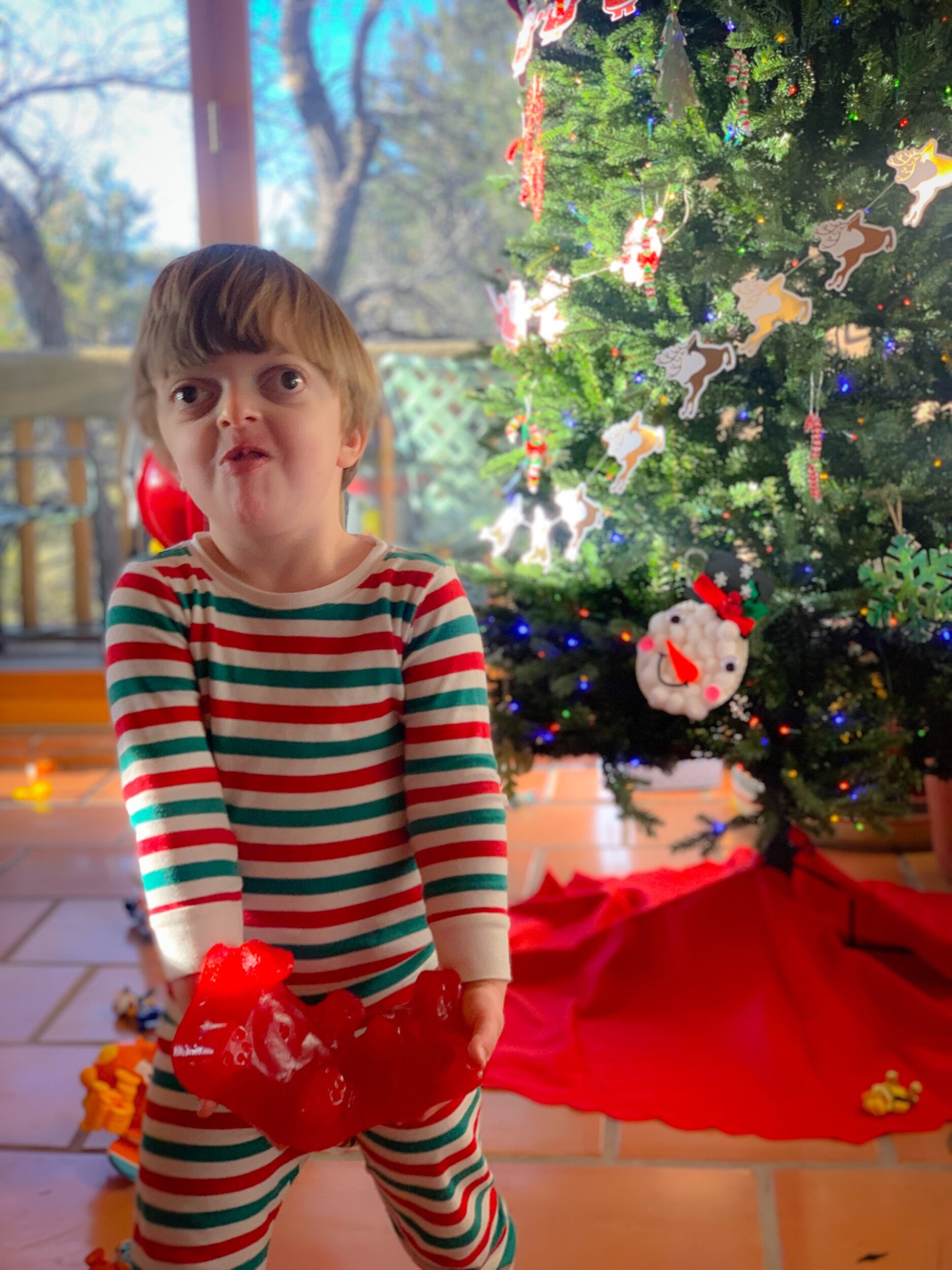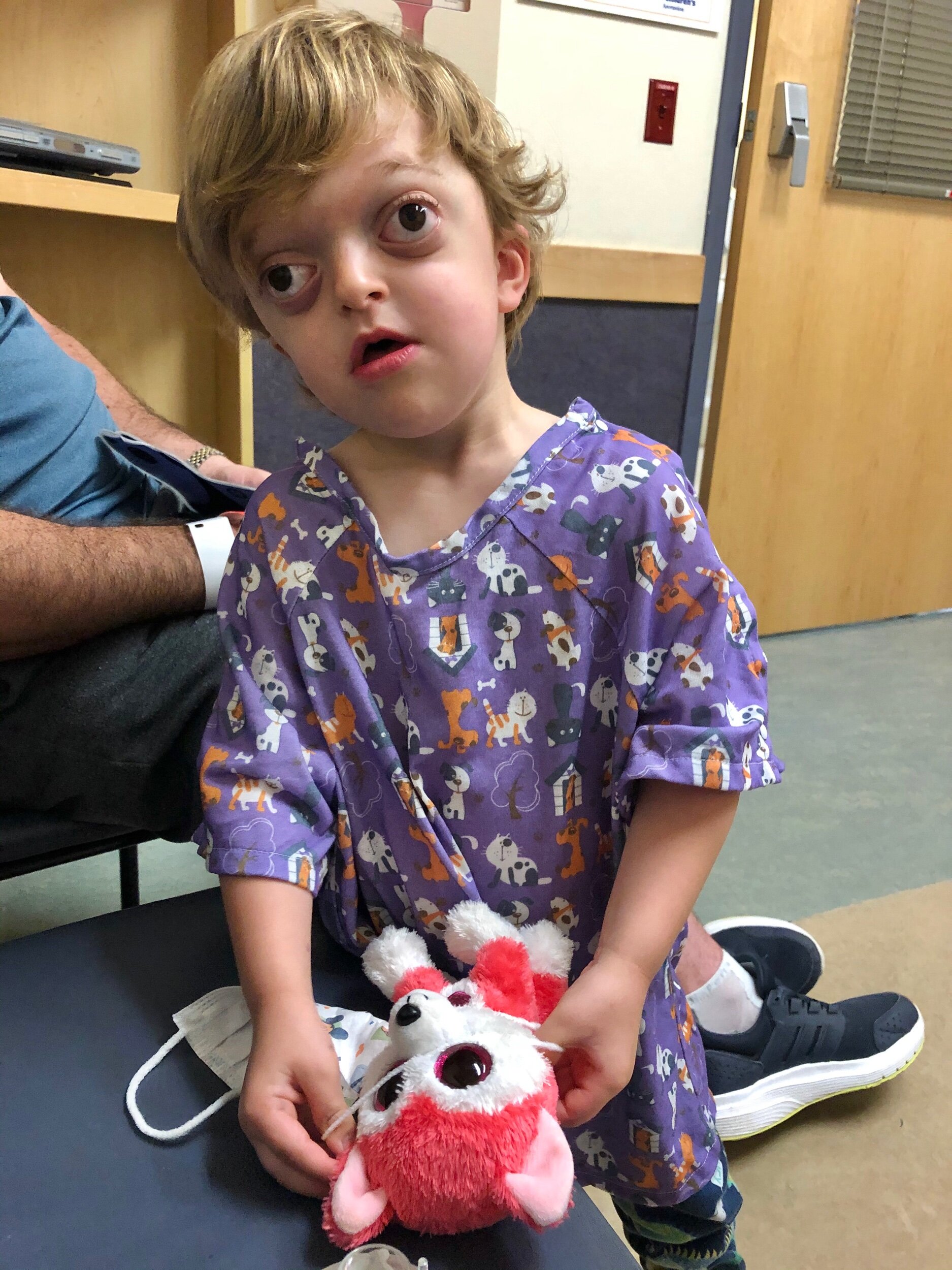Holden’s syndrome requires us to closely monitor four major aspects of his health: breathing, hearing, seeing and intracranial pressure (ICP). I’m overjoyed to report that during the last half of 2020, we have received good news in regards to all four of these categories. I wanted to share a few bright moments my family found during this otherwise distressing and uncertain year.
BREATHING
In June Holden had his tonsils and adenoids removed in the hope that this would improve his severe Obstructive Sleep Apnea. Three months after his surgery, Holden underwent a sleep study to find out if the surgery had helped.
This was Holden’s fifth sleep study and they have all been extremely stressful for him. At one study, he got so upset that he hyperventilated and threw up. In anticipation of his stress, I arrived at the sleep lab with a suitcase full of bribes. My goal was to distract Holden while the polysomnographer (sleep technician) hooked him up to all of the necessary equipment.
First, sensors were glued to his head, face, chest and legs. Then belts were wrapped around his chest and stomach. Finally, a pulse oximeter was placed on his big toe and a nasal cannula was inserted into his nostrils. After that, Holden was just supposed to sleep “normally” while the sleep technician monitored his breathing, oxygen levels, and heart rate.
Holden was aggravated, but I’m happy to report that my bribes worked. He eventually accepted the situation and slept most of the night.
Six weeks later we received the study results.
I cried.
I cried happy, relieved tears. I cried so much I had to explain to the kids what it means to cry “happy tears.” Holden had benefited from his surgery and his sleep apnea was now mild. His Apnea-Hypopnea Index (AHI) dropped from 14 per hour to three per hour. During previous sleep studies, his oxygen level had not remained stable, but this time it had.
We don’t know if or how long this result will last. As Holden continues to grow, his mid face will grow at a slower rate. This could cause a further narrowing of his upper airways and worsen his sleep apnea.
Our hope is that by removing his tonsils and adenoids we bought time for Holden to become mature enough to understand the importance of wearing a CPAP to sleep should he need it. Nevertheless, we are thrilled that for now he is getting better sleep.
HEARING
In my last post, I mentioned that we received great news after Holden’s Auditory Brainstem Response (ABR) test which was done in June under anesthesia. The audiologist determined that Holden only suffered from very mild hearing loss. We left the hospital that day feeling relieved that he did not need a hearing aid.
Fast forward to October when Holden had his follow-up appointment with a different audiologist. At this appointment, Holden took an interactive hearing test while awake. At the end of the test, I was floored when the audiologist turned to me without hesitation and informed me that Holden needed a hearing aid as soon as possible.
I had gone to the appointment confident that this follow-up testing was just part of the protocol. I was stunned with disbelief when I heard this news. I felt angry at the audiologist and wanted to cry in defeat. Based on our struggle to get Holden to wear his CPAP, I knew getting him to wear a hearing device would likely be a hard fought battle.
We spoke to Holden’s ENT and she didn’t feel a hearing aid was necessary at this time. Sam and I have decided we are going to forgo a hearing device for now since two out of three experts feel he doesn’t need one.
Our confidence in our decision is solidified by the fact that Sam and I don’t notice Holden having any issues hearing or understanding us. He is also working with a speech therapist and his language is developing nicely. The kid even speaks Spanish!
SEEING
Like many children with Pfeiffer syndrome, Holden is missing eye muscles which leads to strabismus (misalignment of the eyes). In Holden’s case his left eye wandered significantly upward. In September, he underwent surgery to help straighten it.
Of all of the surgeries Holden has undergone, the manner in which this one was executed is the most confusing to me. Here is my best understanding:
Holden is missing the muscle that is located in the bottom center of the eyeball (the inferior rectus muscle). This muscle moves the eye downward. Since Holden does not have this muscle, his eye wandered upwards. To compensate for this, the neuro ophthalmologist strengthened his left and right eye muscles to help pull his eye into a more centered position.
Fortunately for Holden, the recovery from this surgery was painless. His eye just looked pretty gnarly (think ground beef). The biggest challenge we faced was putting ointment in his eye eight times a day. To say the boy hated it is an understatement. Sam and I had to physically restrain him on more than a few occasions.
At Holden’s post-op appointment the neuro ophthalmologist was thrilled with the new alignment of his left eye. She also noticed that he was not constantly tilting his head to the right anymore. This position had previously helped him line up his eyes so that he could see better.
Then she informed me that Holden would now need surgery on his right eye.
Prior to Holden’s surgery, the misalignment in Holden’s left eye had been so pronounced that his ophthalmologist had not been able to detect the extent of misalignment in his right eye. Thus, Holden will be having a second eye surgery in the next 3-6 months.
This was a small disappointment, but not a huge surprise to Sam and I. Tweaking the eye muscles into alignment for people with craniosynostosis syndromes often takes numerous surgeries. We are just happy our boy’s vision has improved.
ICP MONITORING
Intracranial pressure (ICP) is the pressure around the brain.This is the most critical aspect of Holden’s syndrome that we monitor. If his skull is not growing fast enough to accommodate the rate of his brain growth, a plethora of problems could arise. His ICP is monitored via MRIs and checking his optic nerve pressure.
During his regular visits with his neuro opthamologist over the last year, Holden’s optic nerve pressure was normal. He also underwent a routine MRI approximately one year after his 2019 skull reconstruction surgery.
The result: Holden is not currently showing signs of ICP and there is no need for another cranio vault reconstruction at this time. After putting Holden through this surgery for two years in a row, this was hands down the most joyous news we received in 2020!
I am sharing this news with cautious optimism. Holden’s anatomy will change in irregular ways as he continues to grow, so we can’t predict how these four key areas of his health will evolve over time. For Holden, medical interventions are often steps not solutions.
Regardless, Sam and I count ourselves especially lucky to have something to celebrate during this difficult year. I hope everyone reading this has also managed to find moments of brightness in 2020.







